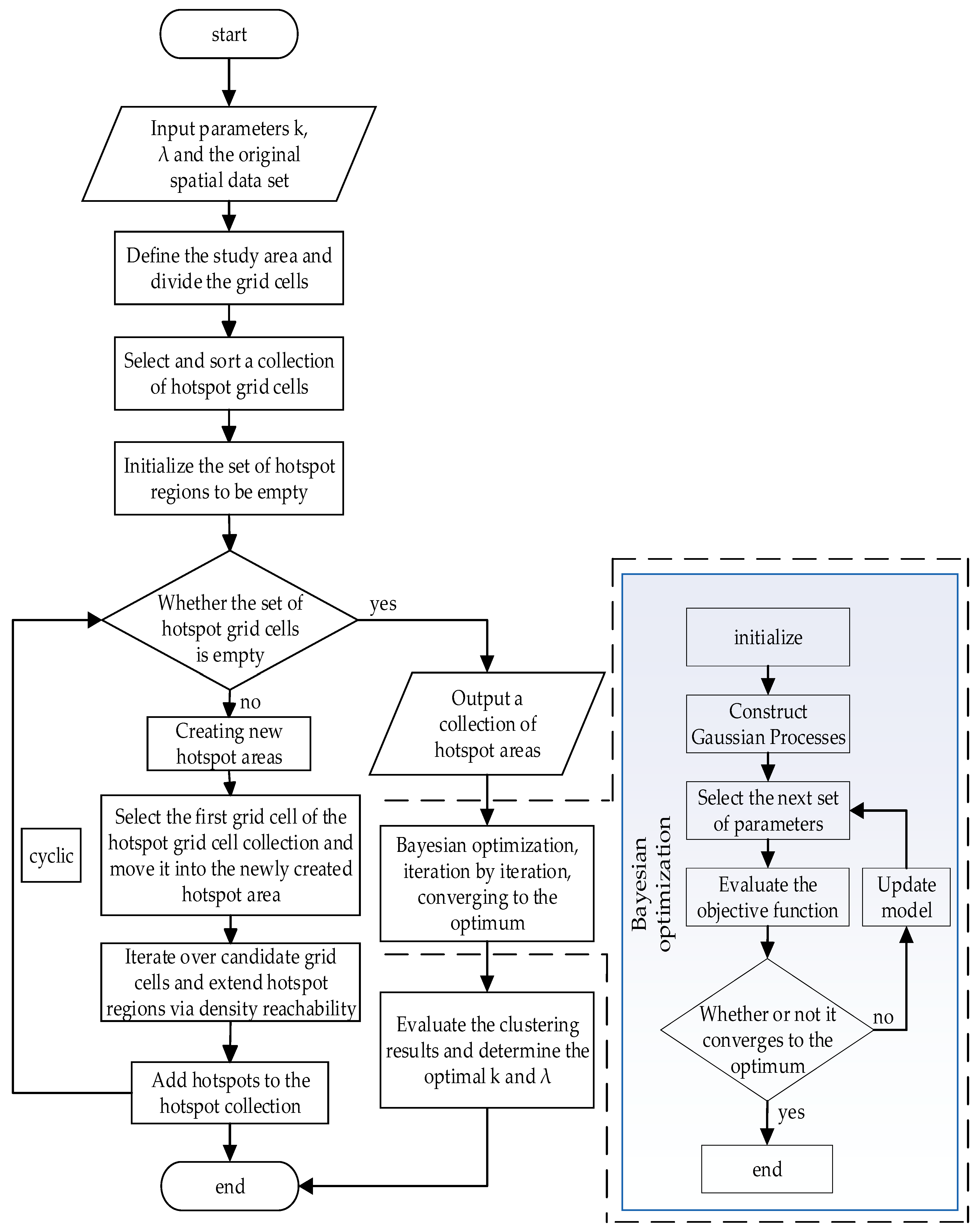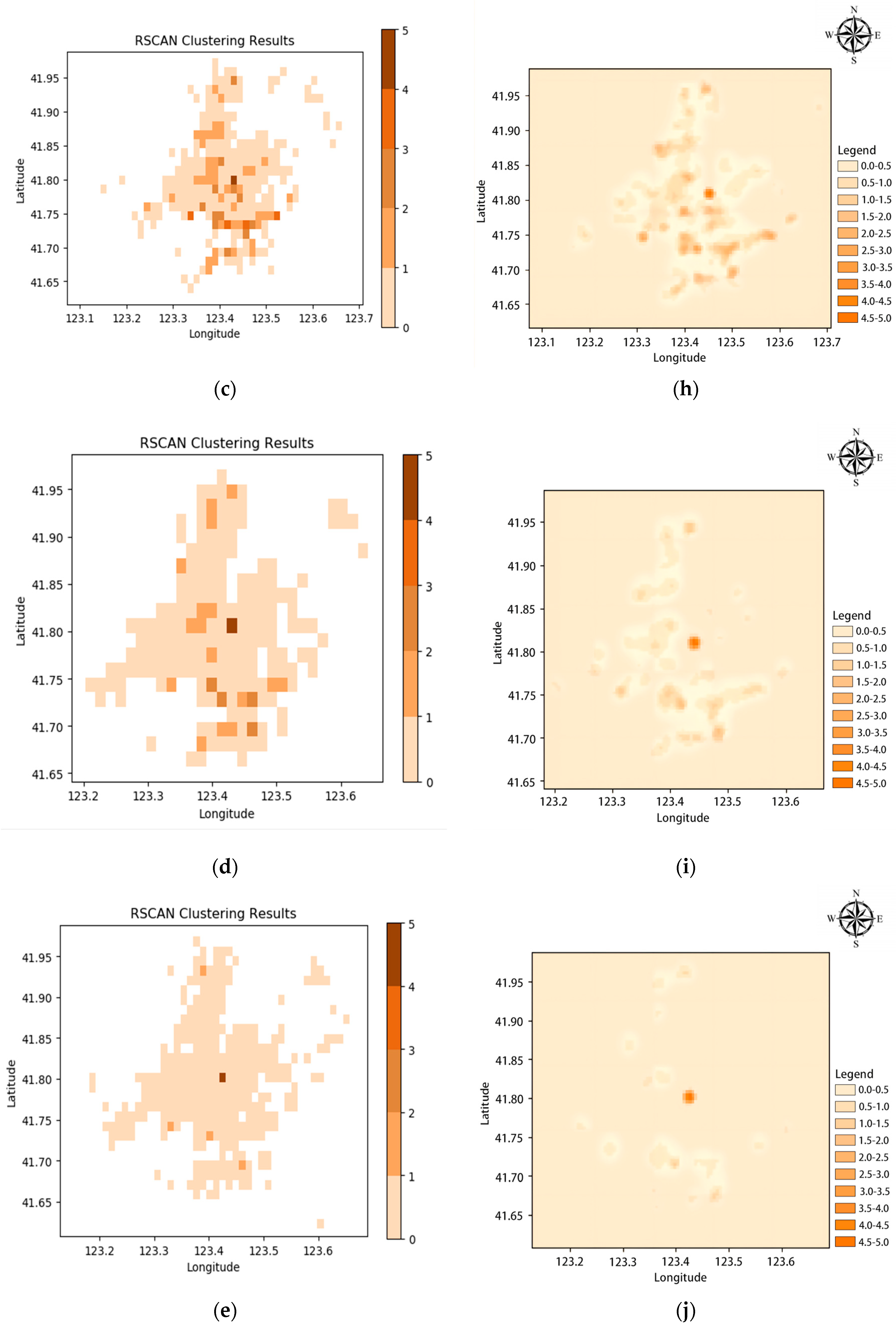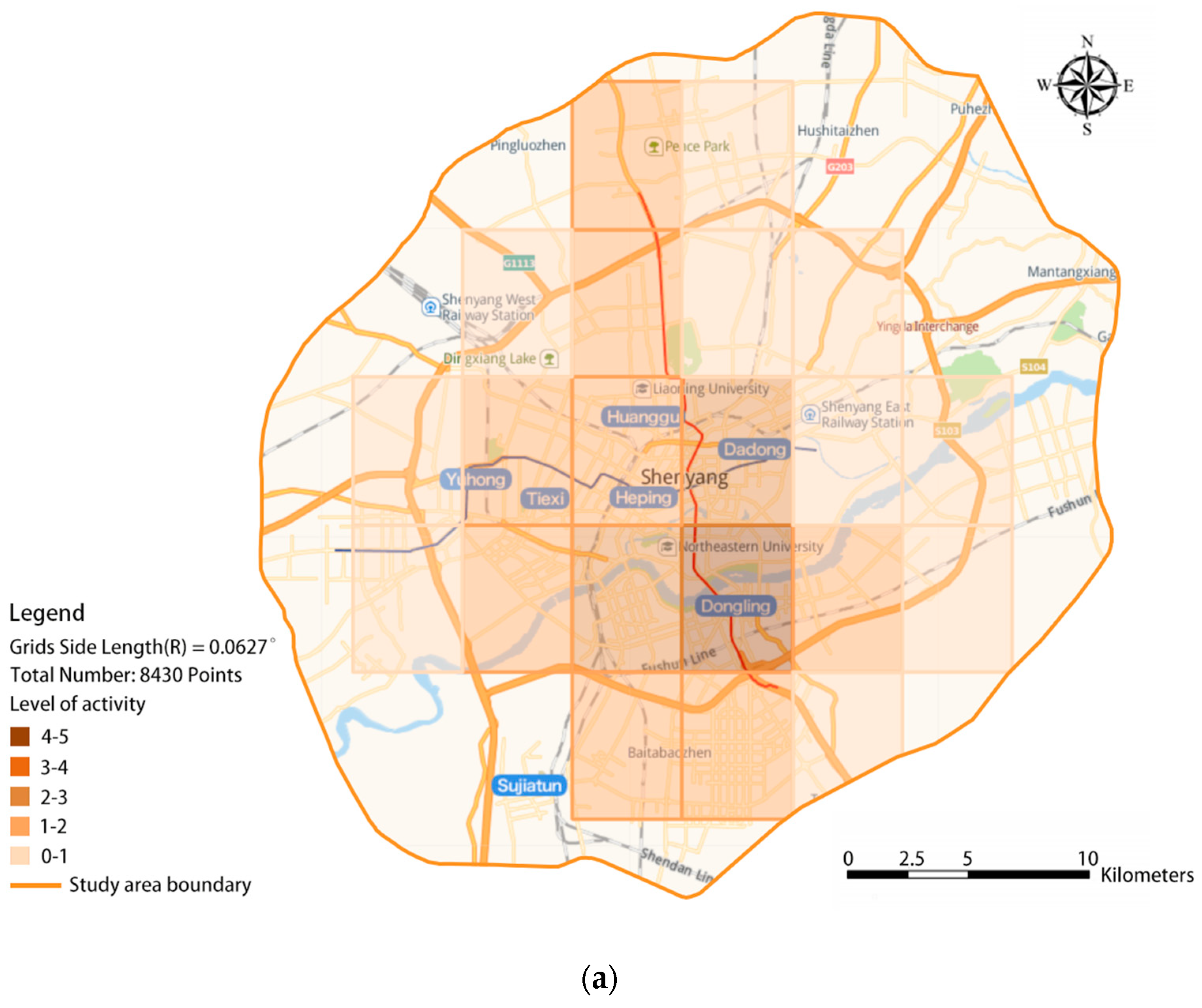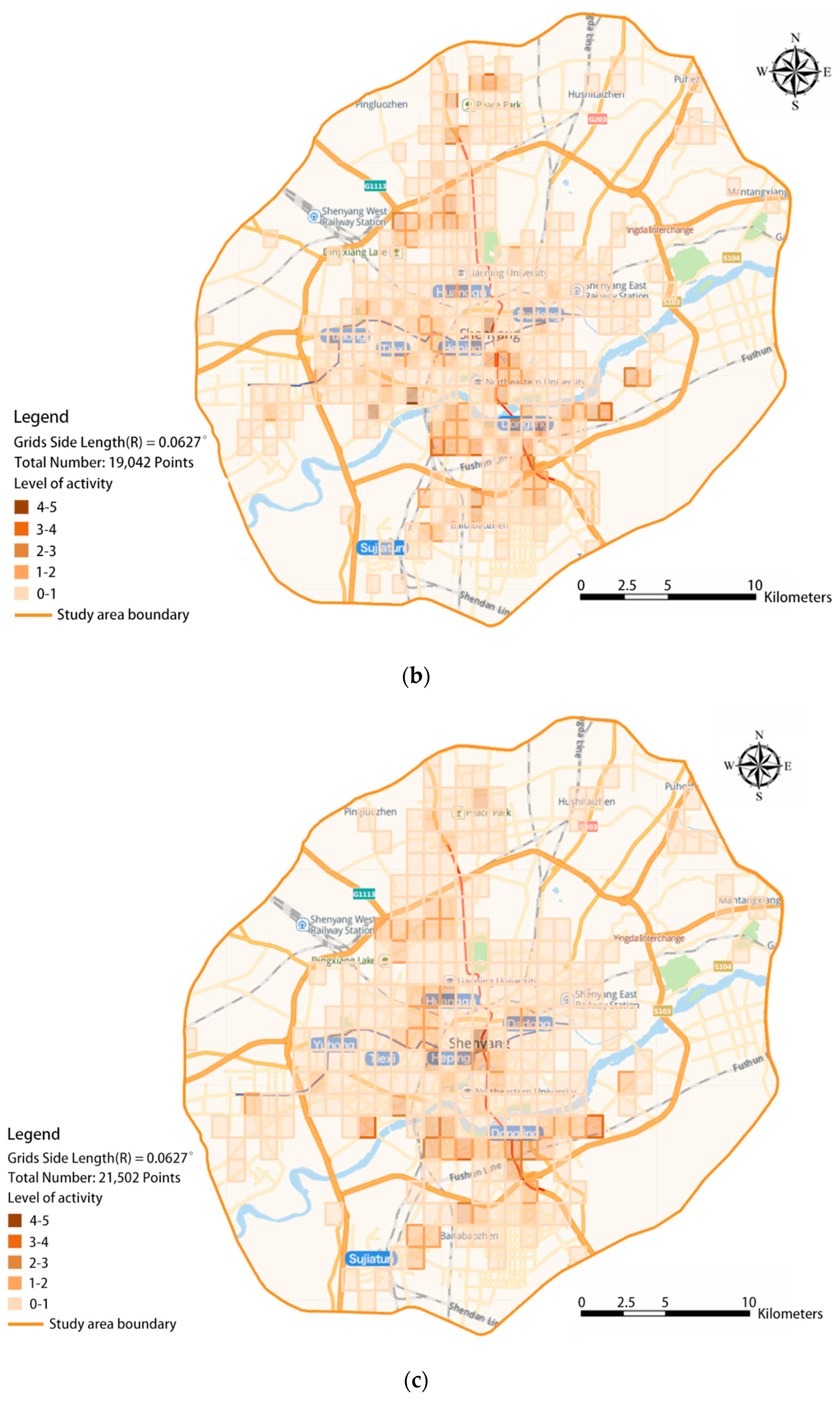Grid Density Algorithm-Based Second-Hand Housing Transaction Activity and Spatio-Temporal Characterization: The Case of Shenyang City, China
Abstract
1. Introduction
- (1)
- Innovations in perspective:
- (2)
- Methodological innovation:
- (3)
- Interdisciplinary research:
2. Materials and Methods
2.1. Data
2.1.1. Data Sources
2.1.2. Data Acquisition
2.1.3. Data Range
- (1)
- Representation: As the capital of Liaoning Province, Shenyang is highly representative of the second-hand housing market in Northeast China. It is an influential economic, cultural, and transportation hub in the region, making it a significant area for study.
- (2)
- Market size: Shenyang boasts a large population, a positive population growth rate, a relatively developed economy, and a substantial second-hand housing market. Studying this market in Shenyang provides comprehensive data, facilitating in-depth analysis and research.
- (3)
- Data availability: Accurate data related to the secondary market are more readily available in Shenyang, which is crucial for conducting both quantitative and qualitative analyses.
2.2. Methods
2.2.1. Methodology
2.2.2. RScan Algorithm Core Content Definition
- (1)
- Definition 1—Region:
- (2)
- Definition 2—Grid length and threshold:
- (3)
- Definition 3—Grid cells:
- (4)
- Definition 4—Grid density:
- (5)
- Definition 5—Active grid cells:
- (6)
- Definition 6—Grid level classification:
- (7)
- Definition 7—Grid reachability:
- (8)
- Definition 8—Grid direct reachability:
- (9)
- Definition 9—Active region:
2.2.3. Evaluation of the RScan Algorithm
2.2.4. RScan Algorithm Steps and Processes
- (1)
- Enter the original spatial dataset with estimates for and as initial values.
- (2)
- The area covered by the spatial data objects is divided into a series of non-overlapping grid cells of size .
- (3)
- Iterate over the original dataset and map the spatial data to the corresponding grid cells using a mapping function.
- (4)
- Calculate the data density within each grid cell to identify hotspot grid cells and remove any common, non-hotspot grid cells.
- (5)
- Analyze the distribution of data points within hotspot grid cells, calculate their locations, and merge them based on proximity to form regions indicative of varying levels of second-hand housing transaction activity.
- (6)
- Apply Bayesian optimization algorithms (BOA) to the grid cell edge length and density threshold , iterating until optimal parameters are achieved.
- (7)
- Assess the performance of the RScan algorithm using the selected clustering evaluation metrics.
- (8)
- Input the improved values for and and repeat steps 1–7 to visualize and refine the active region mining results.
3. Results
3.1. Performance Evaluation Results
3.2. Results of the Spatio-Temporal Evolution of Second-Hand Housing Transaction Activity
4. Discussion
5. Conclusions
- (1)
- Limitations of time span: The dataset used in this research spans from 2018 to 2023. Although this timeframe allows for an analysis of recent changes in the activity of the second-hand housing market in Shenyang, it may not be sufficiently extensive to fully capture the long-term trends of the market. Given the cyclical nature of real estate markets and the delayed effects of policy changes, this shorter duration could restrict a comprehensive understanding of the broader market dynamics.
- (2)
- Lack of research on spatio-temporal dynamic mechanisms: This study primarily documents the shifts in the distribution characteristics of second-hand real estate transaction activity in Shenyang City across different periods. However, it does not delve into the intrinsic dynamic mechanisms driving these changes. Going forward, by addressing the limitations related to the time span, we aim to continue collecting data on second-hand house transactions to enhance the richness of the dataset. This will support a more detailed investigation into the spatio-temporal dynamic change mechanisms, thereby facilitating a more accurate depiction of long-term trends in second-hand house activity. Concurrently, we plan to develop a semantic mining model and integrate theories from economics and sociology to probe into the underlying mechanisms driving changes in the activity of the second-hand housing market.
Author Contributions
Funding
Institutional Review Board Statement
Informed Consent Statement
Data Availability Statement
Acknowledgments
Conflicts of Interest
References
- Li, B.; Li, R.Y.M.; Wareewanich, T. Factors Influencing Large Real Estate Companies’ Competitiveness: A Sustainable Development Perspective. Land 2021, 10, 1239. [Google Scholar] [CrossRef]
- Huang, Y.J.; An, H.C. Impact to the Second-handed Housing Price Made by the Government Policies, Based on the System Dynamics and a Case Study of Second-handed Housing Market of Beijing. In Proceedings of the International Conference on Advances in Management Engineering and Information Technology, Bangkok, Thailand, 28–29 June 2015. [Google Scholar]
- Tian, C.; Ji, W.; Chen, S.; Wu, J. The time and spatial effects of a “City-County merger” on housing prices—Evidence from Fuyang. Sustainability 2020, 12, 1639. [Google Scholar] [CrossRef]
- Li, Y.; Zhu, D.; Zhao, J.; Zheng, X.; Zhang, L. Effect of the housing purchase restriction policy on the Real Estate Market: Evidence from a typical suburb of Beijing, China. Land Use Policy 2020, 94, 104528. [Google Scholar] [CrossRef]
- Peng, Y.; Tian, C. Removal and reconstruction: Multi-period price effects on nearby housing from urban village redevelopment. Land Use Policy 2022, 113, 105877. [Google Scholar] [CrossRef]
- Qi, S.J.; Zhang, T.J.; Zhang, Y.B. Sensitivity Simulation between the New and the Old Residential Real Estate Market on the Basal of System Dynamics. In Proceedings of the International Conference on Industrial Engineering and Management Science (ICIEMS), Shanghai, China, 28–29 September 2013. [Google Scholar]
- Zhang, D.D. Discussion on the Second-hand Commercial Housing Valuation Problems under the Theory of Differential Rent. In Proceedings of the SSR International Conference on Social Sciences and Information (SSR-SSI 2015), Tokyo, Japan, 29–30 November 2015. [Google Scholar]
- Xu, L.; Li, Z. A new appraisal model of second-hand housing prices in China’s first-tier cities based on machine learning algorithms. Comput. Econ. 2021, 57, 617–637. [Google Scholar] [CrossRef]
- Dai, L.; Zhu, A.; Zhao, L.; Wang, C. Establishment of Mass Appraisal of the Estate Benchmark Price by the Mathematics Model of the Least-squares Method. In Proceedings of the 2012 7th International Conference on System of Systems Engineering (SoSE), Genoa, Italy, 16–19 July 2012. [Google Scholar]
- Liu, G.; Zong, X. Research of second-hand real estate price forecasting based on data mining. In Proceedings of the IEEE 2nd Information Technology, Networking, Electronic and Automation Control Conference (ITNEC), Chengdu, China, 15–17 December 2017. [Google Scholar]
- Wang, R.; Li, D.F. Two Bargain Game Models of the Second-Hand Housing Commence. In Proceedings of the 3rd Joint China-Dutch Workshop on Game Theory and Applications/7th China Meeting on Game Theory and Applications (GTA), Fuzhou, China, 20–23 November 2016. [Google Scholar]
- Jingjing, F.; Yan, H. The Analysis of Nash Equilibrium on second-hand housing transactions Based on the Final-offer Arbitration Model. In Proceedings of the 4th International Conference on Social Sciences and Economic Development (ICSSED), Wuhan, China, 15–17 March 2019. [Google Scholar]
- Zhang, X.; Lin, Z.; Zhang, Y.; Zheng, Y.; Zhang, J. Online property brokerage platform and prices of second-hand houses: Evidence from Lianjia’s entry. Electron. Commer. Res. Appl. 2021, 50, 101104. [Google Scholar] [CrossRef]
- Hui, E.C.; Liang, C. The spatial clustering investment behavior in housing markets. Land Use Policy 2015, 42, 7–16. [Google Scholar] [CrossRef]
- Wei, H.M.; Hu, W.J. Research on the Influencing Factors of the Second-Hand Housing Prices Based on Interpretive Structure Model (ISM). In Proceedings of the International Conference on Complex Science Management and Education Science (CSMES), Kuming, China, 23–24 November 2013. [Google Scholar]
- Xu, S.; Zhang, Z. Spatial differentiation and influencing factors of second-hand housing prices: A case study of Binhu new district, Hefei city, Anhui province, China. J. Math. 2021, 2, 8792550. [Google Scholar] [CrossRef]
- Liang, W.; Pan, L.; Sun, J.; Wang, J. Guangzhou House Price Analysis based on Machine Learning Methods.3rd International Conference on Machine Learning, Big Data and Business Intelligence (MLBDBI). Electr. Netw. 2021, 3, 3–5. [Google Scholar]
- Perez-Sanchez, V.R.; Mora-Garcia, R.T.; Perez-Sanchez, J.C.; Cespedes-Lopez, M.F. The influence of the characteristics of second-hand properties on their asking prices: Evidence in the Alicante market. Inf. Constr. 2020, 6, 72–79. [Google Scholar]
- Tan, R.; He, Q.; Zhou, K.; Xie, P. The effect of new metro stations on local land use and housing prices: The case of Wuhan, China. J. Transp. Geogr. 2019, 79, 102488. [Google Scholar] [CrossRef]
- Zhang, L.; Zhou, J.; Hui, E.C.M. Which types of shopping malls affect housing prices? From the perspective of spatial accessibility. Habitat Int. 2020, 96, 102118. [Google Scholar]
- Chen, W.D. Policy failure or success? Detecting market failure in China’s housing market. Econ. Model. 2016, 56, 109–121. [Google Scholar] [CrossRef]
- Ma, S.; Li, T.; Yang, Y. Housing Price Appreciation Effects of Elevator Installation in Old Residential Areas: Empirical Evidence Based on a Multiperiod DID Model. Adv. Civ. Eng. 2022, 2022, 7949–7952. [Google Scholar] [CrossRef]
- Yin, Z.; Sun, R.; Bi, Y. Spatial-temporal change trend analysis of second-hand house price in hefei based on spatial network. Comput. Intell. Neurosci. 2022, 2022, 564–572. [Google Scholar] [CrossRef]
- Zhou, Y.; Fang, Z.; Thill, J.C.; Li, Q.; Li, Y. Functionally critical locations in an urban transportation network: Identification and space–time analysis using taxi trajectories. Comput. Environ. Urban Syst. 2015, 52, 34–47. [Google Scholar] [CrossRef]
- Wang, Y.; Ren, J. Taxi passenger hot spot mining based on a refined K-means++ algorithm. IEEE Access 2021, 9, 66587–66598. [Google Scholar] [CrossRef]
- Shiode, S.; Shiode, N. A network-based scan statistic for detecting the exact location and extent of hotspots along urban streets. Comput. Environ. Urban Syst. 2020, 83, 101500. [Google Scholar] [CrossRef]
- Hall, D.R.; Ngan, C.H.; Zerbe, B.S.; Kozakov, D.; Vajda, S. Hot spot analysis for driving the development of hits into leads in fragment-based drug discovery. J. Chem. Inf. Model. 2012, 52, 199–209. [Google Scholar] [CrossRef]
- Tao, L.; Su, Y.; Fang, X. Global carbon emission spatial pattern in 2030 under INDCs: Using a gridding approach based on population and urbanization. Int. J. Clim. Change Strateg. Manag. 2022, 14, 78–99. [Google Scholar] [CrossRef]
- Lau, B.P.L.; Ng, B.K.K.; Yuen, C.; Tunçer, B.; Chong, K.H. The study of urban residential’s public space activeness using space-centric approach. IEEE Internet Things J. 2021, 8, 11503–11513. [Google Scholar] [CrossRef]
- Elangovan, R.; Vairavasundaram, S.; Varadarajan, V.; Ravi, L. Location-based social network recommendations with computational intelligence-based similarity computation and user check-in behavior. Concurr.Comput. Pract. Exp. 2021, 33, e6106. [Google Scholar] [CrossRef]
- Abdali, E.; Valadan Zoej, M.J.; Taheri Dehkordi, A.; Ghaderpour, E. A parallel-cascaded ensemble of machine learning models for crop type classification in Google earth engine using multi-temporal sentinel-1/2 and landsat-8/9 remote sensing data. Remote Sens. 2023, 16, 127. [Google Scholar] [CrossRef]
- Wang, X.; Zhang, Z.; Luo, Y. Clustering methods based on stay points and grid density for hotspot detection. ISPRS Int. J. Geo-Inf. 2022, 11, 190–197. [Google Scholar] [CrossRef]
- Habib, M.F.; Bridgelall, R.; Motuba, D.; Rahman, B. Exploring the robustness of alternative cluster detection and the threshold distance method for crash hot spot analysis: A study on vulnerable road users. Safety 2023, 9, 57. [Google Scholar] [CrossRef]
- Sultana, N.; Hossain, S.Z.; Abusaad, M.; Alanbar, N.; Senan, Y.; Razzak, S.A. Prediction of biodiesel production from microalgal oil using Bayesian optimization algorithm-based machine learning approaches. Fuel 2022, 309, 122184. [Google Scholar] [CrossRef]
- Aslan, M.F.; Sabanci, K.; Durdu, A.; Unlersen, M.F. COVID-19 diagnosis using state-of-the-art CNN architecture features and Bayesian Optimization. Comput. Biol. Med. 2022, 142, 105244. [Google Scholar] [CrossRef] [PubMed]
- Bai, H.; Li, G.; Liu, C.; Li, B.; Zhang, Z.; Qin, H. Hydrological probabilistic forecasting based on deep learning and Bayesian optimization algorithm. Hydrol. Res. 2021, 52, 927–943. [Google Scholar] [CrossRef]
- Chepiga, T.; Zhilyaev, P.; Ryabov, A.; Simonov, A.P.; Dubinin, O.N.; Firsov, D.G.; Kuzminova, Y.O.; Evlashin, S.A. Process parameter selection for production of stainless steel 316L using efficient multi-objective Bayesian optimization algorithm. Materials 2023, 16, 1050–1053. [Google Scholar] [CrossRef]
- Sultana, N.; Hossain, S.Z.; Almuhaini, S.H.; Düştegör, D. Bayesian optimization algorithm-based statistical and machine learning approaches for forecasting short-term electricity demand. Energies 2022, 15, 3425–3432. [Google Scholar] [CrossRef]
- Wang, Y.; Kandeal, A.W.; Swidan, A.; Sharshir, S.W.; Abdelaziz, G.B.; Halim, M.A.; Kabeel, A.E.; Yang, N. Prediction of tubular solar still performance by machine learning integrated with Bayesian optimization algorithm. Appl. Therm. Eng. 2021, 184, 116233. [Google Scholar] [CrossRef]
- Wang, L.; Yan, X.; Liu, Y.; Liu, X.; Chen, D. Grid mapping for road network abstraction and traffic congestion identification based on probe vehicle data. J. Transp. Eng. Part A Syst. 2021, 147, 04021024. [Google Scholar] [CrossRef]
- Sarmah, S.; Bhattacharyya, D.K. A grid-density based technique for finding clusters in satellite image. Pattern Recognit. Lett. 2012, 33, 589–604. [Google Scholar] [CrossRef]
- Loh, W.K.; Moon, Y.S.; Park, Y.H. Fast density-based clustering using graphics processing units. IEICE Trans. Inf. Syst. 2014, 97, 1349–1352. [Google Scholar] [CrossRef][Green Version]
- Saxena, A.; Prasad, M.; Gupta, A.; Bharill, N.; Patel, O.P.; Tiwari, A.; Er, M.J.; Ding, W.; Lin, C.T. A review of clustering techniques and developments. Neurocomputing 2017, 267, 664–681. [Google Scholar] [CrossRef]
- Chen, X.; Peng, X.; Wang, S.A. Superpixel segmentation based on grid point density peak clustering. Sensors 2021, 21, 6374. [Google Scholar] [CrossRef]
- Zhao, X.; Hu, C.; Liu, Z.; Meng, Y. Weighted dynamic time warping for grid-based travel-demand-pattern clustering: Case study of Beijing bicycle-sharing system. ISPRS Int. J. Geo-Inf. 2019, 8, 281–289. [Google Scholar] [CrossRef]
- Garrido-Merchán, E.C.; Fernández-Sánchez, D.; Hernández-Lobato, D. Parallel predictive entropy search for multi-objective Bayesian optimization with constraints applied to the tuning of machine learning algorithms. Expert Syst. Appl. 2023, 215, 119328. [Google Scholar] [CrossRef]
- Abbas, F.; Zhang, F.; Ismail, M.; Khan, G.; Iqbal, J.; Alrefaei, A.F.; Albeshr, M.F. Optimizing machine learning algorithms for landslide susceptibility mapping along the Karakoram Highway, Gilgit Baltistan, Pakistan: A comparative study of baseline, bayesian, and metaheuristic hyperparameter optimization techniques. Sensors 2023, 23, 6843–6847. [Google Scholar] [CrossRef] [PubMed]
- Tani, L.; Veelken, C. Comparison of Bayesian and particle swarm algorithms for hyperparameter optimisation in machine learning applications in high energy physics. Comput. Phys. Commun. 2024, 294, 108955. [Google Scholar] [CrossRef]
- Zhao, Y.; Cao, J.; Zhang, C.; Zhang, S. Enhancing grid-density based clustering for high dimensional data. J. Syst. Softw. 2011, 84, 1524–1539. [Google Scholar] [CrossRef]
- Wang, B. Housing market volatility under COVID-19: Diverging response of demand in luxury and low-end housing markets. Land Use Policy 2022, 119, 106191. [Google Scholar] [CrossRef] [PubMed]







| Time/Area | Tiexi District /Unit | Heping District /Unit | Shenhe District /Unit | Hunnan District /Unit | Dadong District /Unit | Huanggu District /Unit | Yuhong District /Unit | Sujiatun District /Unit | Shenbei New District /Unit | Total /Unit |
|---|---|---|---|---|---|---|---|---|---|---|
| 2018–2019 | 1160 | 1199 | 772 | 2662 | 443 | 380 | 1096 | 165 | 553 | 8430 |
| 2019–2020 | 2374 | 2367 | 1840 | 4474 | 1008 | 1436 | 3198 | 514 | 1831 | 19,042 |
| 2020–2021 | 2673 | 3048 | 1685 | 4601 | 1280 | 2216 | 3368 | 750 | 1881 | 21,502 |
| 2021–2022 | 1938 | 1999 | 643 | 3374 | 869 | 1364 | 2112 | 408 | 1497 | 14,204 |
| 2022–2023 | 3310 | 3649 | 955 | 5775 | 1231 | 2726 | 3154 | 665 | 2989 | 24,454 |
| Define | Elucidate |
|---|---|
| Longitude range | This range includes the longitudes of all data points in the dataset, where denotes the minimum longitude and denotes the maximum longitude. |
| Latitude range | This range encompasses the latitudes of all data points in the dataset, where denotes the minimum latitude and represents the maximum latitude. |
| This covers all the latitude and longitude location data, forming a collection of rectangular regions with longitude ranging from to and latitude ranging from to . = ,, The region D contains all the data points in the entire spatial dataset and covers all the latitude and longitude location data in a minimal rectangular fashion. |
| Serial Number | Condition | Element |
|---|---|---|
| 1 | Denseness | For , where represents an independently active grid cell. |
| 2 | Connectivity | For and , there exists a path defined by grid density reachability, ensuring that every intermediate grid cell in the path also belongs to the subset . This indicates that grid cells within the active region are interconnected through grid density reachability. |
| 3 | Maximality | For , if any grid cell is grid density reachable from , then . |
| Time Period | Optimal k-Value (°) | Optimal λ-Value (Number) | Silhouette Coefficient | Davies-Bouldin Index (DBI) |
|---|---|---|---|---|
| 2018–2019 | 0.0627 | 4 | 0.4217 | 0.0280 |
| 2019–2020 | 0.0106 | 3 | 0.3639 | 0.0687 |
| 2020–2021 | 0.0133 | 7 | 0.3882 | 0.0686 |
| 2021–2022 | 0.0157 | 9 | 0.3932 | 0.0603 |
| 2022–2023 | 0.0119 | 3 | 0.4455 | 0.0720 |
Disclaimer/Publisher’s Note: The statements, opinions and data contained in all publications are solely those of the individual author(s) and contributor(s) and not of MDPI and/or the editor(s). MDPI and/or the editor(s) disclaim responsibility for any injury to people or property resulting from any ideas, methods, instructions or products referred to in the content. |
© 2024 by the authors. Licensee MDPI, Basel, Switzerland. This article is an open access article distributed under the terms and conditions of the Creative Commons Attribution (CC BY) license (https://creativecommons.org/licenses/by/4.0/).
Share and Cite
Ren, J.; Gao, X. Grid Density Algorithm-Based Second-Hand Housing Transaction Activity and Spatio-Temporal Characterization: The Case of Shenyang City, China. ISPRS Int. J. Geo-Inf. 2024, 13, 286. https://doi.org/10.3390/ijgi13080286
Ren J, Gao X. Grid Density Algorithm-Based Second-Hand Housing Transaction Activity and Spatio-Temporal Characterization: The Case of Shenyang City, China. ISPRS International Journal of Geo-Information. 2024; 13(8):286. https://doi.org/10.3390/ijgi13080286
Chicago/Turabian StyleRen, Jiaqiang, and Xiaomeng Gao. 2024. "Grid Density Algorithm-Based Second-Hand Housing Transaction Activity and Spatio-Temporal Characterization: The Case of Shenyang City, China" ISPRS International Journal of Geo-Information 13, no. 8: 286. https://doi.org/10.3390/ijgi13080286
APA StyleRen, J., & Gao, X. (2024). Grid Density Algorithm-Based Second-Hand Housing Transaction Activity and Spatio-Temporal Characterization: The Case of Shenyang City, China. ISPRS International Journal of Geo-Information, 13(8), 286. https://doi.org/10.3390/ijgi13080286




